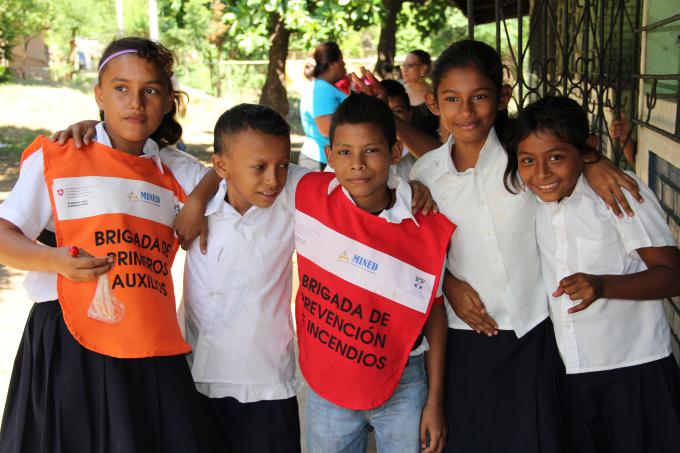 Nicaragua
Nicaragua
Idiomas
Children training for a possible emergency
Institutions involved in DIPECHO evaluate risks in the “Republic of Costa Rica” School in Ciudad Sandino
At nine in the morning the bell rings in the “Republic of Costa Rica” primary school, which is located in the southeast of the municipality of Ciudad Sandino. The bell is warning the children to immediately evacuate their classrooms following the established evacuation routes and make their way to the designated safety areas.
This exercise, which simulates an earthquake situation, is testing out the school’s capacity to protect and safeguard the lives of the children who study there. One of the greatest risks in this school is a wall that is over ten meters high, which was built by a private company to guarantee the safety of the school’s assets. However, it also represents a latent threat for the children as there are signs that cracks are appearing in its structure.
Third-grade student Joseling Figueroa explained that “In response to a tremor situation we have to leave calmly, without running, because we could fall and hit other classmates. The teachers have taught us that we have to put our hands above our heads while leaving the classrooms and go to the most open part of the school because we’re going to be safer there.”
Given the condition of vulnerability in this school due to the wall, the teachers, students and parents have become aware of the importance of being prepared and the school holds simulations every month in order to be ready to respond to a possible emergency.
“Our priority as teachers is to protect and safeguard the lives of the students and that’s why we have to teach them techniques to protect and look after themselves in case of emergencies,” said teacher Aura Luz Valle, who is also the school’s director.
The children, who were still restless following the activity they had just participated in, stressed that in recent months their teachers have been training them in techniques related to how to act during emergency situations.
Prior to the exercise, the teachers explained the importance of this kind of activity to the pupils, bearing in mind that the knowledge acquired at school of the safety norms that need to be implemented can also be applied in their homes.
Dayanna Solís, who is the mother of one of the students, recalled that five years ago over 100 families were moved from the ruined buildings of old Managua, destroyed by an earthquake back in 1972, to the new residential area of Vía La Concha in the municipality of Ciudad Sandino. “As mothers, we were aware of the risks we were running in the ruins of Managua and we know we’re safer here in this area,” she said proudly. “But we still mustn’t lower our guard of being prepared to protect our children.”
In the coming months, the organizations that work with DIPECHO—such as the Co-Management of the National Disaster Prevention, Mitigation and Response System (SINAPRED) and the Education Ministry’s Technical Unit—will accompany this school in developing a prevention model for high-magnitude events. The aim here is to increase the knowledge required for the school to act appropriately in response to an emergency.

